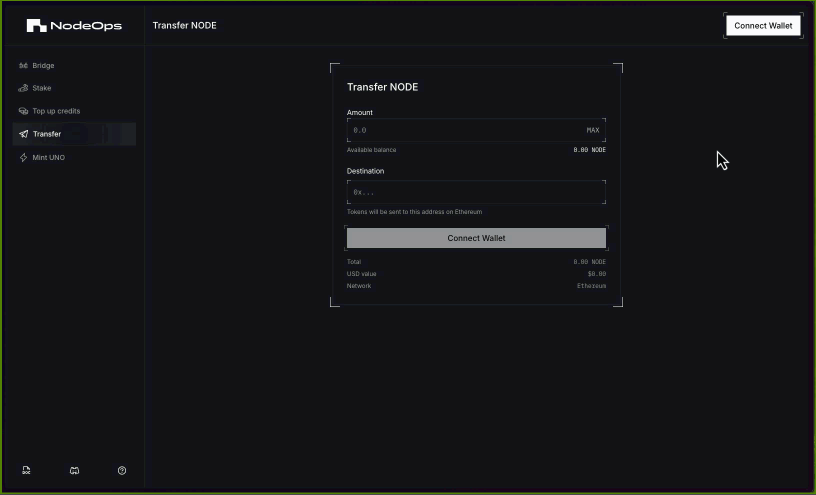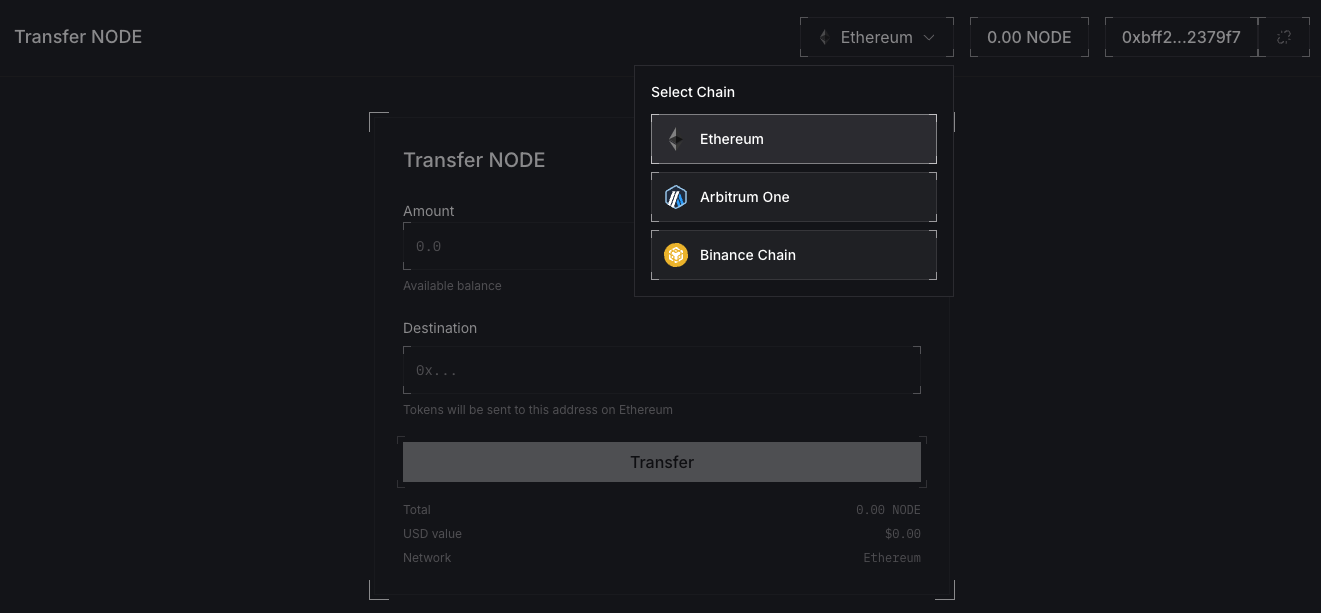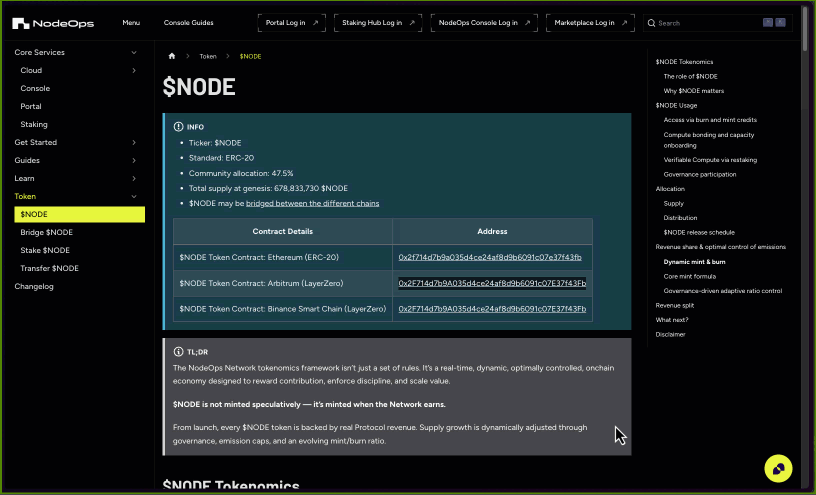Token
FAQ
What is $NODE?
$NODE is the native utility token of the NodeOps Network.
What is the utility of $NODE?
$NODE is the native utility token of the NodeOps Network. It's part of the coordination layer enabling Node deployments, Compute purchases, staking incentives, governance, and more.
What is $NODE's contract address?
| Contract details | Address |
|---|---|
| $NODE Token Contract: Ethereum (ERC-20) | 0x2f714d7b9a035d4ce24af8d9b6091c07e37f43fb |
| $NODE Token Contract: Arbitrum (LayerZero) | 0x2F714d7b9A035d4ce24af8d9b6091c07E37f43Fb |
| $NODE Token Contract: Binance Smart Chain (LayerZero) | 0x2F714d7b9A035d4ce24af8d9b6091c07E37f43Fb |
Where can I lean about $NODE from a third-party source?
CoinMarketCap details $NODE and NodeOps.
What CEX support $NODE?
$NODE may be traded on several popular exchanges, including:
- Binance Alpha
- Bitget
- BingX
- Bitmart
- Bitunix
- Bybit
- DigiFinix
- Gate
- HTX
- Kraken
- Kucoin
- LBank
- MEXC
- Pancakeswap
Can anyone buy $NODE?
No.
$NODE is not available to individuals or entities located in, under the control of, residents, or nationals of the following restricted jurisdictions: Afghanistan, Canada, China, Iran, Iraq, North Korea, Pakistan, Syria, Ukraine, the United States, the United States Minor Outlying Islands, and the US Virgin Islands.
Additionally, $NODE is unavailable to any individual or entity subject to sanctions or listed on any sanctions list maintained by the United Nations, the United States (including OFAC’s SDN and Entity Lists), the European Union or its Member States, the United Kingdom, or any other applicable governmental authority — regardless of location. For additional information, ensure to thoroughly review our Terms and Conditions of the $NODE airdrop.
How do I see the $NODE in my wallet?
NodeOps Portal lets you view your $NODE balance.
Show me a quick tutorial
Show me video

-
Log in to the portal.nodeops.network/transfer with your relevant wallet.
-
Select the chain your $NODE is on.
The airdropped $NODE is on Arbitrum One.
Show me

- You balance now shows at the top right of the dashboard.
Show me

Alternatively, you can add a custom token to most wallets:
Show me a quick tutorial

Wallets differ slightly in their flows, this demonstration uses MetaMask.
-
Log in to your wallet.
-
From the Tokens tab, select the hamburger menu and click Import tokens.
-
Click Custom token, and select the chain your $NODE is on.
-
Copy the $NODE token address and enter it into the Token contract address field:
| Contract details | Address |
|---|---|
| $NODE Token Contract: Ethereum (ERC-20) | 0x2f714d7b9a035d4ce24af8d9b6091c07e37f43fb |
| $NODE Token Contract: Arbitrum (LayerZero) | 0x2F714d7b9A035d4ce24af8d9b6091c07E37f43Fb |
| $NODE Token Contract: Binance Smart Chain (LayerZero) | 0x2F714d7b9A035d4ce24af8d9b6091c07E37f43Fb |
This demo shows Arbitrum One's $NODE.
- If the token symbol comes up as NODE, you're good to go, click Next.
Congratulations, your $NODE holdings are now visible in your wallet.
Will there be a public sale or IDO?
Yes, the IDO went live in June 2025 and was exclusive to Binance Wallet via PancakeSwap.
Which wallet should I use to receive the airdrop?
Any EVM-compatible wallet connected to your NodeOps account is valid. Make sure your wallet is funded for gas when claiming.
How do I earn $NODE?
gNODE is earned through Protocol participation allowing users to later convert this to $NODE:
- Become a Template developer and earn rewards when users run workloads via your code
- Provide Compute
- Earn higher rewards when you assign your machine/s workloads
- Verify the Protocol
- Top up with credits: Burn $10 or more $NODE to earn Credits and unlock multipliers that boost your future rewards
- Deploy Nodes: Use the NodeOps Console to deploy Nodes or workloads
- Farm Compute / rent a machine: Lease Compute from the Marketplace
- Mint a UNO NFT: Mint a UNO NFT to gain ecosystem perks, future governance access, and airdrop eligibility
- Stake $NODE or supported tokens with NodeOps Portal
- Launch UNO-enabled CU
What does holding $NODE mean?
$NODE holders can:
- Trade $NODE
- Convert $NODE into credits for use in-app
- Engage in governance
Does holding $NODE give me governance rights?
Yes $NODE and UNO holders are eligible to vote.
- Standard participation: staked and bonded $NODE tokens carry equal voting weight (1 token = 1 vote).
- Universal Node Orchestrator (UNO) Operator participation: each UNO operator receives a voting weight of 2,000 $NODE tokens for every UNO NFT they hold.
What are NPs?
gNODE replaces NPs. NPs (Node Points) were earned by users for participating in the NodeOps ecosystem. For every $1 spent, you earned 0.5 NPs. They also offer allowlisted access to future Node sales and potential ecosystem airdrops.
What happens to my Wave-1 airdropped $NODE?
Wave-1 $NODE allocations have already been included in the amounts visible on the eligibility checker page. As of now, Wave 1 tokens will remain non-transferable until further updates are announced.
What is Wave-1 & Wave-2?
Wave-3: gNODE replaces the previous reward points. Wave-1 $NODE airdrop was a non-transferable reward token for early users. Wave-2 was the next phase of $NODE distribution to reward the community that has committed to the project since Wave-1.
Is $NODE transferable?
✅ Once $NODE is listed on exchanges, all IDO and airdropped tokens will be transferable. Other tokens, however are still under locks or vesting.
Which exchanges can I trade $NODE on?
From June 30th 2025, $NODE became available on selected exchanges, over time more exchanges listed the token for sale.
$NODE may be traded on several popular exchanges, including:
- Binance Alpha
- Bitget
- BingX
- Bitmart
- Bitunix
- Bybit
- DigiFinix
- Gate
- HTX
- Kraken
- Kucoin
- LBank
- MEXC
- Pancakeswap
Is $NODE inflationary or deflationary?
$NODE is initially inflationary with a dynamic emission model with capped daily supply. The early inflationary emissions exist to reward early contributors. However, a reducing emission algorithm with the associated burn mechanism will offset this, pushing the system toward a deflationary process. Learn more from the $NODE tokenomics.
$NODE burns
Why doesn't the burn wallet use 0xdead?
The burn wallet's custom address is provably irrecoverable and hardcoded in the $NODE contract for added security. It functions identically to 0xdead but with enforced immutability. We created a dedicated burn address because NodeOps’ tokenomics require ongoing, verifiable burn events. By anchoring all burns to a single, hard-coded address, the community can easily track every transaction in one place, ensuring maximum transparency and auditability over time.
How can I verify $NODE burns myself?
Visit the burn transaction link 0x2080FeE444118AFCe30fCb749802C18c0a980dB7, inspect the balance, and check the $NODE contract for transfer restrictions.
Will all $NODE burns use the same address?
Yes, all future burns will go to the address 0x2080FeE444118AFCe30fCb749802C18c0a980dB7.
What is a burn address?
A burn address is a special address where tokens sent and can never be recovered. It is not a wallet, not a deployable contract, and has no private key — making it mathematically impossible to retrieve tokens once burned.
How much $NODE was burned in the first event?
20,365,011.90 $NODE was permanently burned, equal to 3% of total supply and 18.02% of circulating supply.
How does the burn tie into $NODE tokenomics?
Under the dynamic mint-and-burn model, all new emissions are tied to verifiable network revenue. Tokens are minted only when backed by usage, and burned as part of ongoing cycles. Every burn flows through the official address, making supply adjustments transparent, enforceable, and onchain-verifiable.
How does the $NODE burn approach improve on conventional burn models?
Many protocols burn tokens as a symbolic gesture or by convention. NodeOps enforces burns at the contract level and locks them to a dedicated address. This removes trust assumptions, eliminates manipulation risks, and provides onchain proof that every reduction is permanent.
Are $NODE burn rates fixed?
No. Burn rates dynamically tuned to network usage, with parameters to be set and refined through governance. What we’re implementing isn’t a separate or single instance “Proof of Burn” model, but rather the next phase of implementing our dynamic mint-and-burn tokenomics. As adoption and revenue scale, the NodeOps economy ensures supply adjusts transparently and sustainably in line with the growth of NodeOps Network.